Social Justice in Curriculum: Formal and Hidden Evaluation Essay
VerifiedAdded on 2023/06/03
|11
|4089
|458
Essay
AI Summary
This essay evaluates the formal and hidden curriculum of a school from a social justice perspective. It examines the implications of this analysis for both the hidden curriculum and the content, pedagogy, and assessment of the formal curriculum. The essay includes an evaluation of the formal school curriculum from a social justice standpoint, supported by evidence, as well as an evaluation of the hidden curriculum, also supported by evidence. It proposes changes to the school's hidden curriculum where necessary and discusses implications for pedagogy and student assessment, all within the framework of promoting social justice and equality in education.
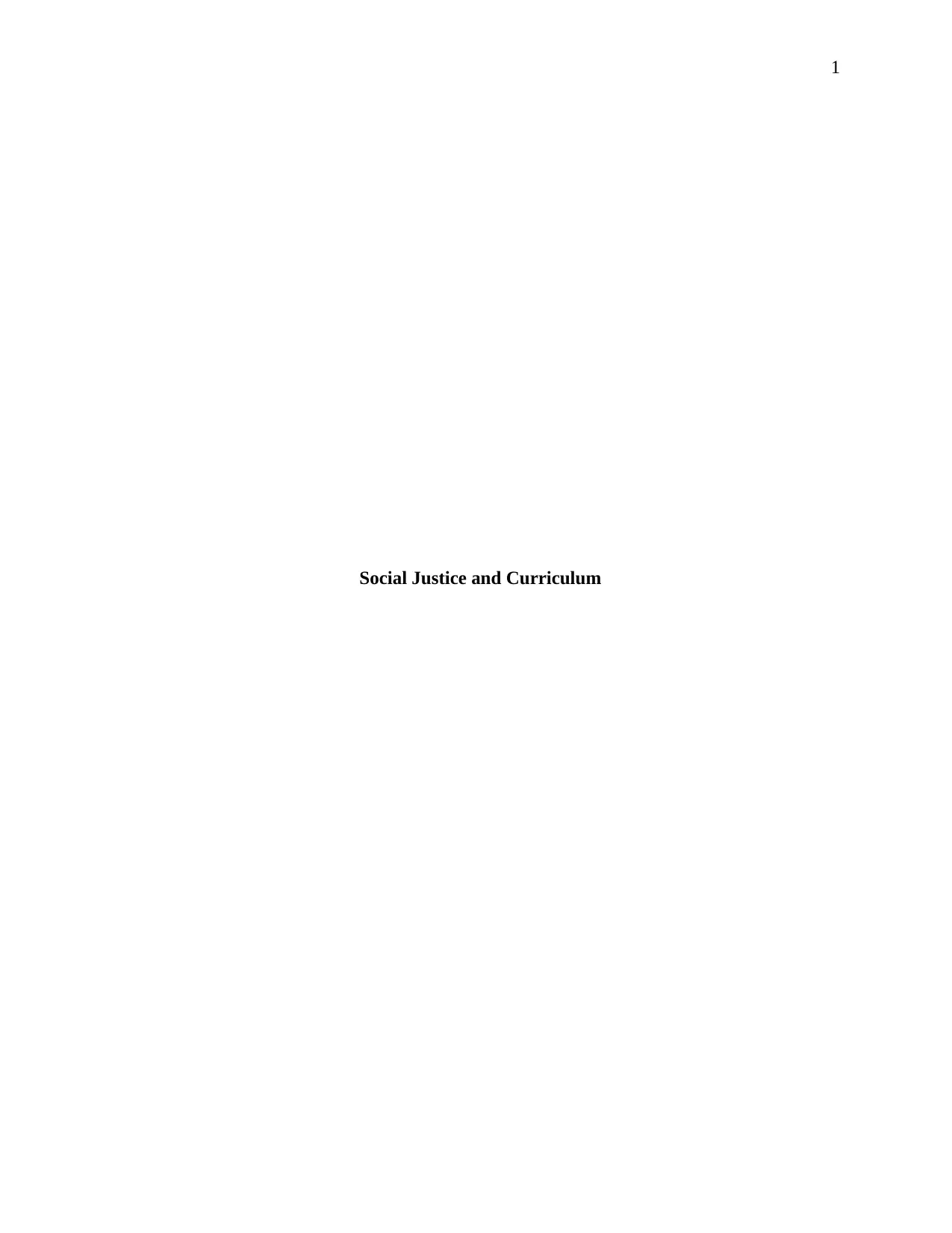
1
Social Justice and Curriculum
Social Justice and Curriculum
Paraphrase This Document
Need a fresh take? Get an instant paraphrase of this document with our AI Paraphraser
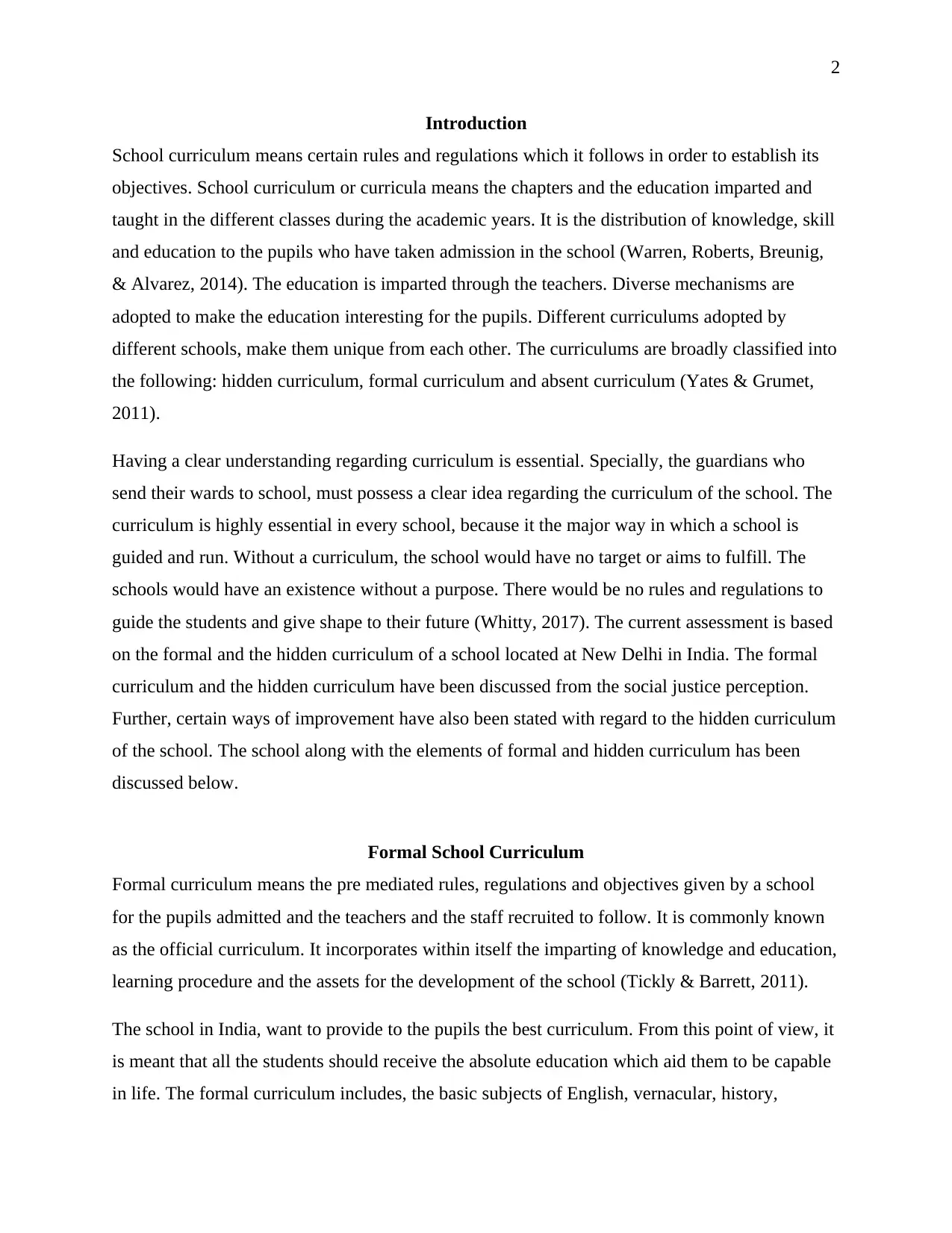
2
Introduction
School curriculum means certain rules and regulations which it follows in order to establish its
objectives. School curriculum or curricula means the chapters and the education imparted and
taught in the different classes during the academic years. It is the distribution of knowledge, skill
and education to the pupils who have taken admission in the school (Warren, Roberts, Breunig,
& Alvarez, 2014). The education is imparted through the teachers. Diverse mechanisms are
adopted to make the education interesting for the pupils. Different curriculums adopted by
different schools, make them unique from each other. The curriculums are broadly classified into
the following: hidden curriculum, formal curriculum and absent curriculum (Yates & Grumet,
2011).
Having a clear understanding regarding curriculum is essential. Specially, the guardians who
send their wards to school, must possess a clear idea regarding the curriculum of the school. The
curriculum is highly essential in every school, because it the major way in which a school is
guided and run. Without a curriculum, the school would have no target or aims to fulfill. The
schools would have an existence without a purpose. There would be no rules and regulations to
guide the students and give shape to their future (Whitty, 2017). The current assessment is based
on the formal and the hidden curriculum of a school located at New Delhi in India. The formal
curriculum and the hidden curriculum have been discussed from the social justice perception.
Further, certain ways of improvement have also been stated with regard to the hidden curriculum
of the school. The school along with the elements of formal and hidden curriculum has been
discussed below.
Formal School Curriculum
Formal curriculum means the pre mediated rules, regulations and objectives given by a school
for the pupils admitted and the teachers and the staff recruited to follow. It is commonly known
as the official curriculum. It incorporates within itself the imparting of knowledge and education,
learning procedure and the assets for the development of the school (Tickly & Barrett, 2011).
The school in India, want to provide to the pupils the best curriculum. From this point of view, it
is meant that all the students should receive the absolute education which aid them to be capable
in life. The formal curriculum includes, the basic subjects of English, vernacular, history,
Introduction
School curriculum means certain rules and regulations which it follows in order to establish its
objectives. School curriculum or curricula means the chapters and the education imparted and
taught in the different classes during the academic years. It is the distribution of knowledge, skill
and education to the pupils who have taken admission in the school (Warren, Roberts, Breunig,
& Alvarez, 2014). The education is imparted through the teachers. Diverse mechanisms are
adopted to make the education interesting for the pupils. Different curriculums adopted by
different schools, make them unique from each other. The curriculums are broadly classified into
the following: hidden curriculum, formal curriculum and absent curriculum (Yates & Grumet,
2011).
Having a clear understanding regarding curriculum is essential. Specially, the guardians who
send their wards to school, must possess a clear idea regarding the curriculum of the school. The
curriculum is highly essential in every school, because it the major way in which a school is
guided and run. Without a curriculum, the school would have no target or aims to fulfill. The
schools would have an existence without a purpose. There would be no rules and regulations to
guide the students and give shape to their future (Whitty, 2017). The current assessment is based
on the formal and the hidden curriculum of a school located at New Delhi in India. The formal
curriculum and the hidden curriculum have been discussed from the social justice perception.
Further, certain ways of improvement have also been stated with regard to the hidden curriculum
of the school. The school along with the elements of formal and hidden curriculum has been
discussed below.
Formal School Curriculum
Formal curriculum means the pre mediated rules, regulations and objectives given by a school
for the pupils admitted and the teachers and the staff recruited to follow. It is commonly known
as the official curriculum. It incorporates within itself the imparting of knowledge and education,
learning procedure and the assets for the development of the school (Tickly & Barrett, 2011).
The school in India, want to provide to the pupils the best curriculum. From this point of view, it
is meant that all the students should receive the absolute education which aid them to be capable
in life. The formal curriculum includes, the basic subjects of English, vernacular, history,
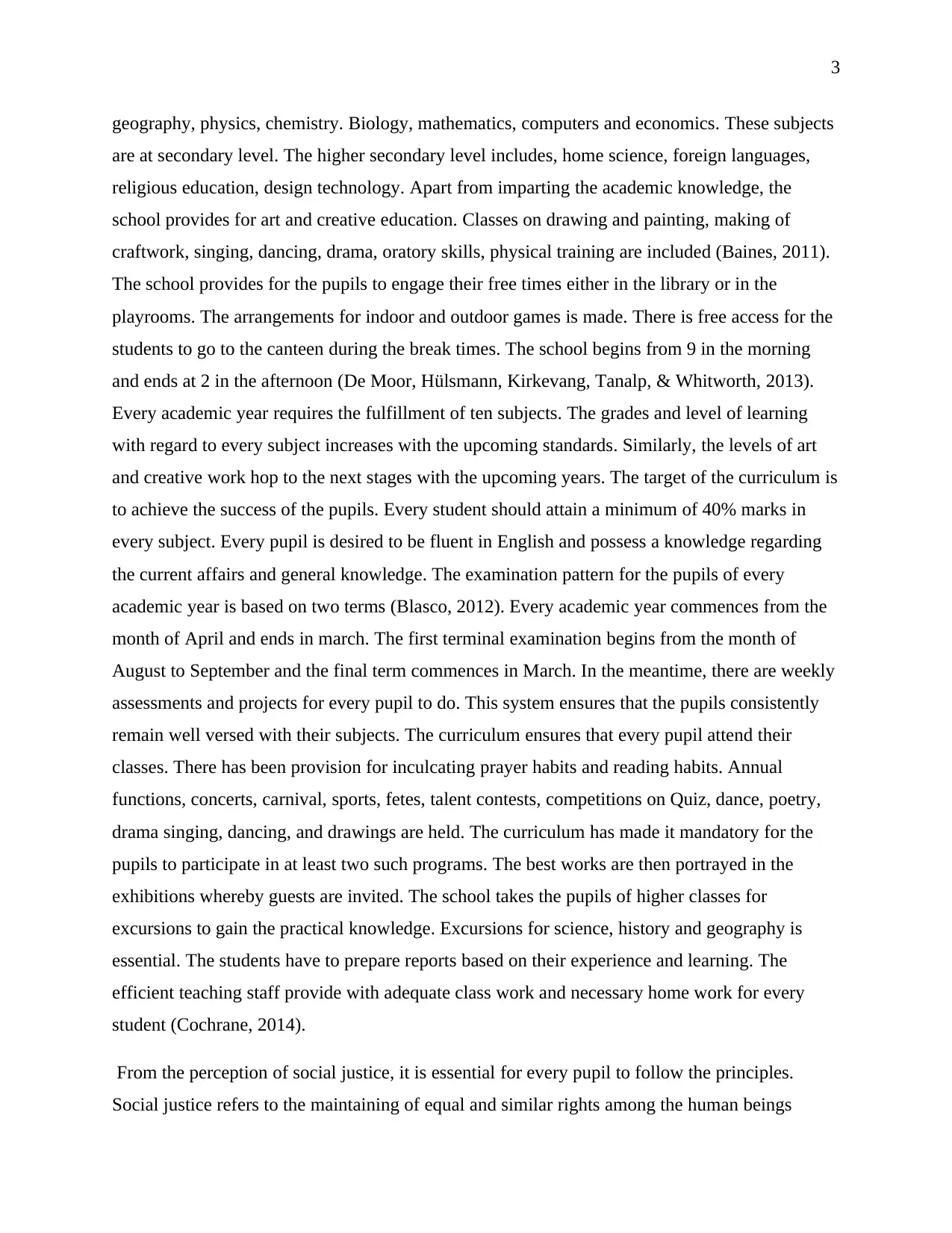
3
geography, physics, chemistry. Biology, mathematics, computers and economics. These subjects
are at secondary level. The higher secondary level includes, home science, foreign languages,
religious education, design technology. Apart from imparting the academic knowledge, the
school provides for art and creative education. Classes on drawing and painting, making of
craftwork, singing, dancing, drama, oratory skills, physical training are included (Baines, 2011).
The school provides for the pupils to engage their free times either in the library or in the
playrooms. The arrangements for indoor and outdoor games is made. There is free access for the
students to go to the canteen during the break times. The school begins from 9 in the morning
and ends at 2 in the afternoon (De Moor, Hülsmann, Kirkevang, Tanalp, & Whitworth, 2013).
Every academic year requires the fulfillment of ten subjects. The grades and level of learning
with regard to every subject increases with the upcoming standards. Similarly, the levels of art
and creative work hop to the next stages with the upcoming years. The target of the curriculum is
to achieve the success of the pupils. Every student should attain a minimum of 40% marks in
every subject. Every pupil is desired to be fluent in English and possess a knowledge regarding
the current affairs and general knowledge. The examination pattern for the pupils of every
academic year is based on two terms (Blasco, 2012). Every academic year commences from the
month of April and ends in march. The first terminal examination begins from the month of
August to September and the final term commences in March. In the meantime, there are weekly
assessments and projects for every pupil to do. This system ensures that the pupils consistently
remain well versed with their subjects. The curriculum ensures that every pupil attend their
classes. There has been provision for inculcating prayer habits and reading habits. Annual
functions, concerts, carnival, sports, fetes, talent contests, competitions on Quiz, dance, poetry,
drama singing, dancing, and drawings are held. The curriculum has made it mandatory for the
pupils to participate in at least two such programs. The best works are then portrayed in the
exhibitions whereby guests are invited. The school takes the pupils of higher classes for
excursions to gain the practical knowledge. Excursions for science, history and geography is
essential. The students have to prepare reports based on their experience and learning. The
efficient teaching staff provide with adequate class work and necessary home work for every
student (Cochrane, 2014).
From the perception of social justice, it is essential for every pupil to follow the principles.
Social justice refers to the maintaining of equal and similar rights among the human beings
geography, physics, chemistry. Biology, mathematics, computers and economics. These subjects
are at secondary level. The higher secondary level includes, home science, foreign languages,
religious education, design technology. Apart from imparting the academic knowledge, the
school provides for art and creative education. Classes on drawing and painting, making of
craftwork, singing, dancing, drama, oratory skills, physical training are included (Baines, 2011).
The school provides for the pupils to engage their free times either in the library or in the
playrooms. The arrangements for indoor and outdoor games is made. There is free access for the
students to go to the canteen during the break times. The school begins from 9 in the morning
and ends at 2 in the afternoon (De Moor, Hülsmann, Kirkevang, Tanalp, & Whitworth, 2013).
Every academic year requires the fulfillment of ten subjects. The grades and level of learning
with regard to every subject increases with the upcoming standards. Similarly, the levels of art
and creative work hop to the next stages with the upcoming years. The target of the curriculum is
to achieve the success of the pupils. Every student should attain a minimum of 40% marks in
every subject. Every pupil is desired to be fluent in English and possess a knowledge regarding
the current affairs and general knowledge. The examination pattern for the pupils of every
academic year is based on two terms (Blasco, 2012). Every academic year commences from the
month of April and ends in march. The first terminal examination begins from the month of
August to September and the final term commences in March. In the meantime, there are weekly
assessments and projects for every pupil to do. This system ensures that the pupils consistently
remain well versed with their subjects. The curriculum ensures that every pupil attend their
classes. There has been provision for inculcating prayer habits and reading habits. Annual
functions, concerts, carnival, sports, fetes, talent contests, competitions on Quiz, dance, poetry,
drama singing, dancing, and drawings are held. The curriculum has made it mandatory for the
pupils to participate in at least two such programs. The best works are then portrayed in the
exhibitions whereby guests are invited. The school takes the pupils of higher classes for
excursions to gain the practical knowledge. Excursions for science, history and geography is
essential. The students have to prepare reports based on their experience and learning. The
efficient teaching staff provide with adequate class work and necessary home work for every
student (Cochrane, 2014).
From the perception of social justice, it is essential for every pupil to follow the principles.
Social justice refers to the maintaining of equal and similar rights among the human beings
⊘ This is a preview!⊘
Do you want full access?
Subscribe today to unlock all pages.

Trusted by 1+ million students worldwide
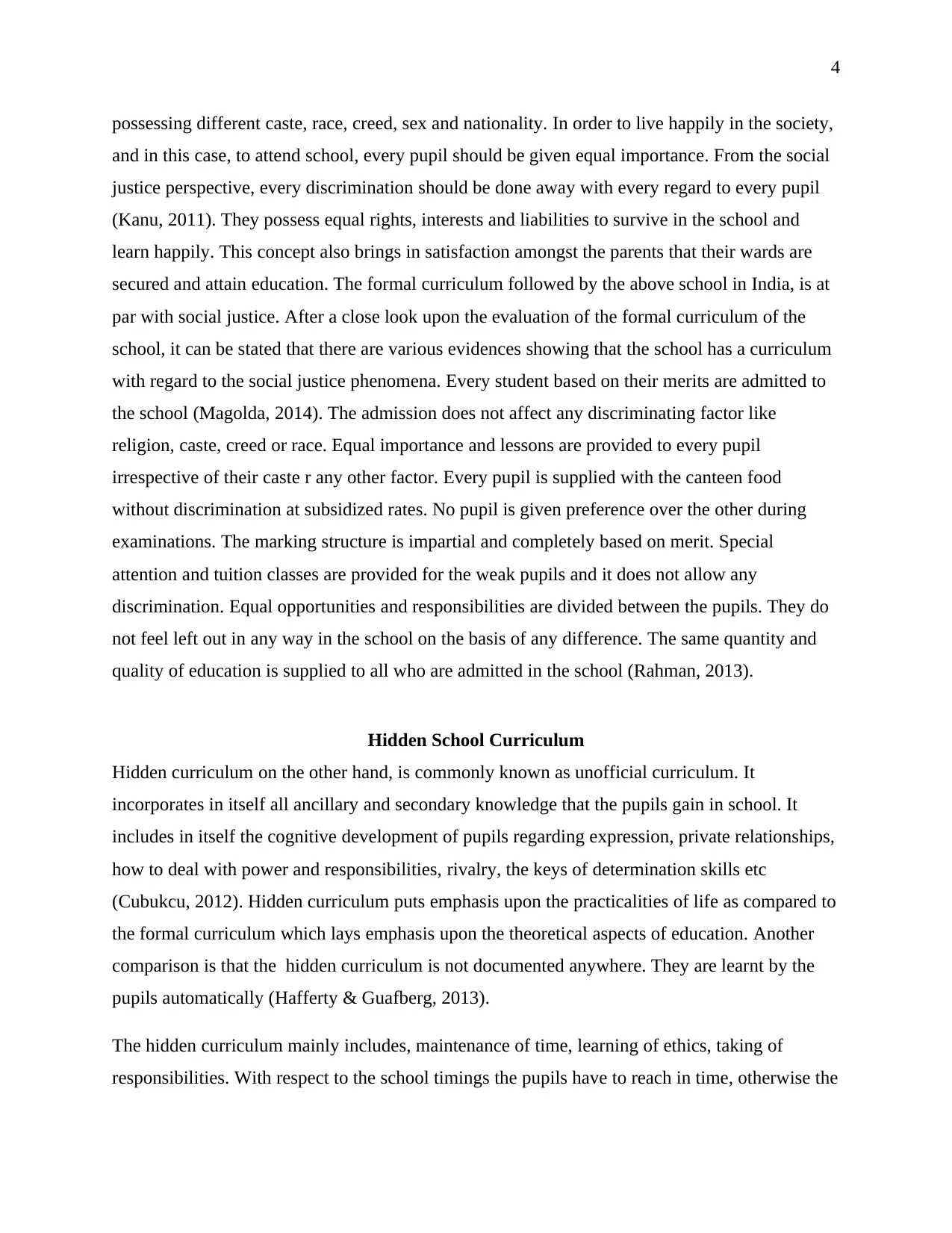
4
possessing different caste, race, creed, sex and nationality. In order to live happily in the society,
and in this case, to attend school, every pupil should be given equal importance. From the social
justice perspective, every discrimination should be done away with every regard to every pupil
(Kanu, 2011). They possess equal rights, interests and liabilities to survive in the school and
learn happily. This concept also brings in satisfaction amongst the parents that their wards are
secured and attain education. The formal curriculum followed by the above school in India, is at
par with social justice. After a close look upon the evaluation of the formal curriculum of the
school, it can be stated that there are various evidences showing that the school has a curriculum
with regard to the social justice phenomena. Every student based on their merits are admitted to
the school (Magolda, 2014). The admission does not affect any discriminating factor like
religion, caste, creed or race. Equal importance and lessons are provided to every pupil
irrespective of their caste r any other factor. Every pupil is supplied with the canteen food
without discrimination at subsidized rates. No pupil is given preference over the other during
examinations. The marking structure is impartial and completely based on merit. Special
attention and tuition classes are provided for the weak pupils and it does not allow any
discrimination. Equal opportunities and responsibilities are divided between the pupils. They do
not feel left out in any way in the school on the basis of any difference. The same quantity and
quality of education is supplied to all who are admitted in the school (Rahman, 2013).
Hidden School Curriculum
Hidden curriculum on the other hand, is commonly known as unofficial curriculum. It
incorporates in itself all ancillary and secondary knowledge that the pupils gain in school. It
includes in itself the cognitive development of pupils regarding expression, private relationships,
how to deal with power and responsibilities, rivalry, the keys of determination skills etc
(Cubukcu, 2012). Hidden curriculum puts emphasis upon the practicalities of life as compared to
the formal curriculum which lays emphasis upon the theoretical aspects of education. Another
comparison is that the hidden curriculum is not documented anywhere. They are learnt by the
pupils automatically (Hafferty & Guafberg, 2013).
The hidden curriculum mainly includes, maintenance of time, learning of ethics, taking of
responsibilities. With respect to the school timings the pupils have to reach in time, otherwise the
possessing different caste, race, creed, sex and nationality. In order to live happily in the society,
and in this case, to attend school, every pupil should be given equal importance. From the social
justice perspective, every discrimination should be done away with every regard to every pupil
(Kanu, 2011). They possess equal rights, interests and liabilities to survive in the school and
learn happily. This concept also brings in satisfaction amongst the parents that their wards are
secured and attain education. The formal curriculum followed by the above school in India, is at
par with social justice. After a close look upon the evaluation of the formal curriculum of the
school, it can be stated that there are various evidences showing that the school has a curriculum
with regard to the social justice phenomena. Every student based on their merits are admitted to
the school (Magolda, 2014). The admission does not affect any discriminating factor like
religion, caste, creed or race. Equal importance and lessons are provided to every pupil
irrespective of their caste r any other factor. Every pupil is supplied with the canteen food
without discrimination at subsidized rates. No pupil is given preference over the other during
examinations. The marking structure is impartial and completely based on merit. Special
attention and tuition classes are provided for the weak pupils and it does not allow any
discrimination. Equal opportunities and responsibilities are divided between the pupils. They do
not feel left out in any way in the school on the basis of any difference. The same quantity and
quality of education is supplied to all who are admitted in the school (Rahman, 2013).
Hidden School Curriculum
Hidden curriculum on the other hand, is commonly known as unofficial curriculum. It
incorporates in itself all ancillary and secondary knowledge that the pupils gain in school. It
includes in itself the cognitive development of pupils regarding expression, private relationships,
how to deal with power and responsibilities, rivalry, the keys of determination skills etc
(Cubukcu, 2012). Hidden curriculum puts emphasis upon the practicalities of life as compared to
the formal curriculum which lays emphasis upon the theoretical aspects of education. Another
comparison is that the hidden curriculum is not documented anywhere. They are learnt by the
pupils automatically (Hafferty & Guafberg, 2013).
The hidden curriculum mainly includes, maintenance of time, learning of ethics, taking of
responsibilities. With respect to the school timings the pupils have to reach in time, otherwise the
Paraphrase This Document
Need a fresh take? Get an instant paraphrase of this document with our AI Paraphraser
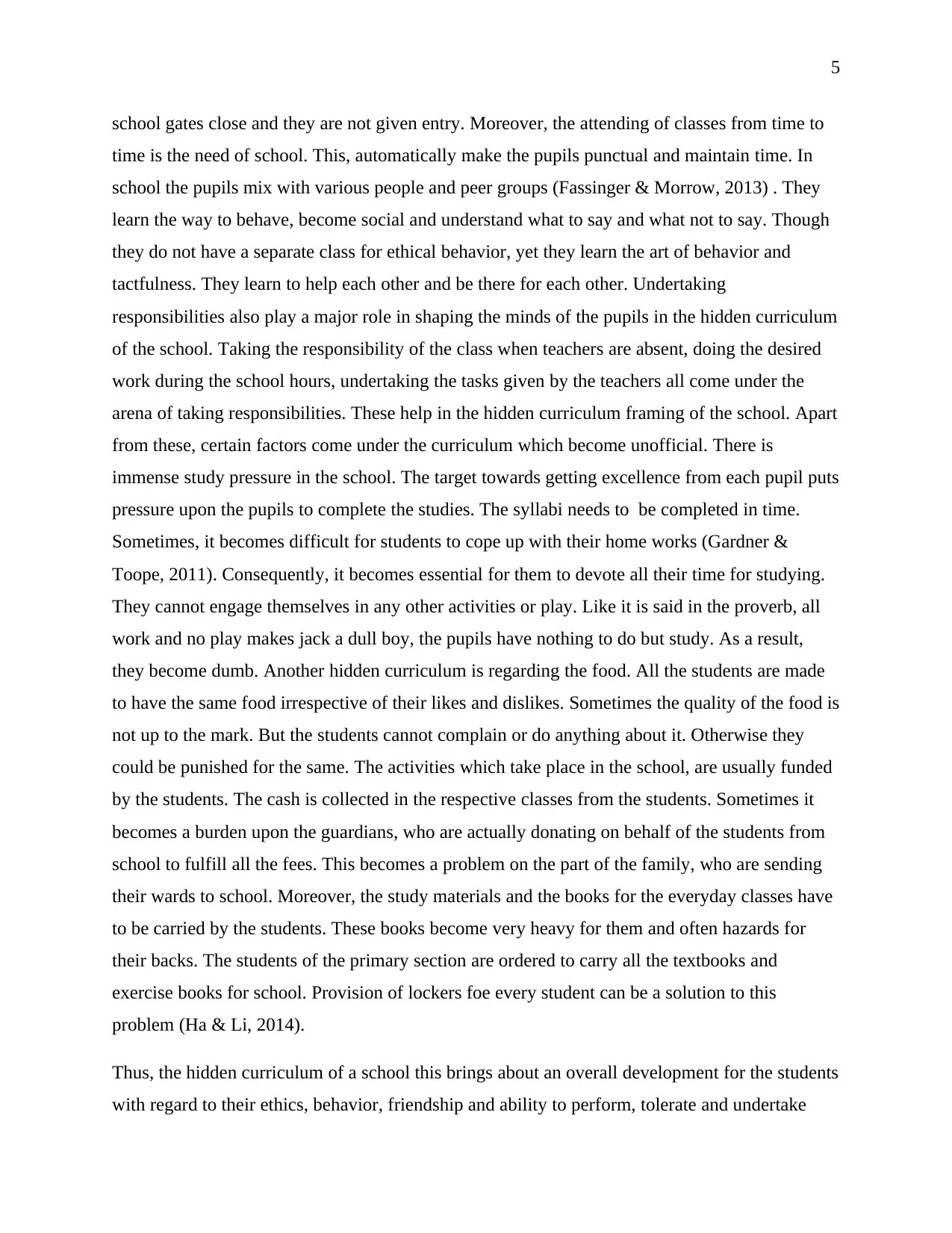
5
school gates close and they are not given entry. Moreover, the attending of classes from time to
time is the need of school. This, automatically make the pupils punctual and maintain time. In
school the pupils mix with various people and peer groups (Fassinger & Morrow, 2013) . They
learn the way to behave, become social and understand what to say and what not to say. Though
they do not have a separate class for ethical behavior, yet they learn the art of behavior and
tactfulness. They learn to help each other and be there for each other. Undertaking
responsibilities also play a major role in shaping the minds of the pupils in the hidden curriculum
of the school. Taking the responsibility of the class when teachers are absent, doing the desired
work during the school hours, undertaking the tasks given by the teachers all come under the
arena of taking responsibilities. These help in the hidden curriculum framing of the school. Apart
from these, certain factors come under the curriculum which become unofficial. There is
immense study pressure in the school. The target towards getting excellence from each pupil puts
pressure upon the pupils to complete the studies. The syllabi needs to be completed in time.
Sometimes, it becomes difficult for students to cope up with their home works (Gardner &
Toope, 2011). Consequently, it becomes essential for them to devote all their time for studying.
They cannot engage themselves in any other activities or play. Like it is said in the proverb, all
work and no play makes jack a dull boy, the pupils have nothing to do but study. As a result,
they become dumb. Another hidden curriculum is regarding the food. All the students are made
to have the same food irrespective of their likes and dislikes. Sometimes the quality of the food is
not up to the mark. But the students cannot complain or do anything about it. Otherwise they
could be punished for the same. The activities which take place in the school, are usually funded
by the students. The cash is collected in the respective classes from the students. Sometimes it
becomes a burden upon the guardians, who are actually donating on behalf of the students from
school to fulfill all the fees. This becomes a problem on the part of the family, who are sending
their wards to school. Moreover, the study materials and the books for the everyday classes have
to be carried by the students. These books become very heavy for them and often hazards for
their backs. The students of the primary section are ordered to carry all the textbooks and
exercise books for school. Provision of lockers foe every student can be a solution to this
problem (Ha & Li, 2014).
Thus, the hidden curriculum of a school this brings about an overall development for the students
with regard to their ethics, behavior, friendship and ability to perform, tolerate and undertake
school gates close and they are not given entry. Moreover, the attending of classes from time to
time is the need of school. This, automatically make the pupils punctual and maintain time. In
school the pupils mix with various people and peer groups (Fassinger & Morrow, 2013) . They
learn the way to behave, become social and understand what to say and what not to say. Though
they do not have a separate class for ethical behavior, yet they learn the art of behavior and
tactfulness. They learn to help each other and be there for each other. Undertaking
responsibilities also play a major role in shaping the minds of the pupils in the hidden curriculum
of the school. Taking the responsibility of the class when teachers are absent, doing the desired
work during the school hours, undertaking the tasks given by the teachers all come under the
arena of taking responsibilities. These help in the hidden curriculum framing of the school. Apart
from these, certain factors come under the curriculum which become unofficial. There is
immense study pressure in the school. The target towards getting excellence from each pupil puts
pressure upon the pupils to complete the studies. The syllabi needs to be completed in time.
Sometimes, it becomes difficult for students to cope up with their home works (Gardner &
Toope, 2011). Consequently, it becomes essential for them to devote all their time for studying.
They cannot engage themselves in any other activities or play. Like it is said in the proverb, all
work and no play makes jack a dull boy, the pupils have nothing to do but study. As a result,
they become dumb. Another hidden curriculum is regarding the food. All the students are made
to have the same food irrespective of their likes and dislikes. Sometimes the quality of the food is
not up to the mark. But the students cannot complain or do anything about it. Otherwise they
could be punished for the same. The activities which take place in the school, are usually funded
by the students. The cash is collected in the respective classes from the students. Sometimes it
becomes a burden upon the guardians, who are actually donating on behalf of the students from
school to fulfill all the fees. This becomes a problem on the part of the family, who are sending
their wards to school. Moreover, the study materials and the books for the everyday classes have
to be carried by the students. These books become very heavy for them and often hazards for
their backs. The students of the primary section are ordered to carry all the textbooks and
exercise books for school. Provision of lockers foe every student can be a solution to this
problem (Ha & Li, 2014).
Thus, the hidden curriculum of a school this brings about an overall development for the students
with regard to their ethics, behavior, friendship and ability to perform, tolerate and undertake
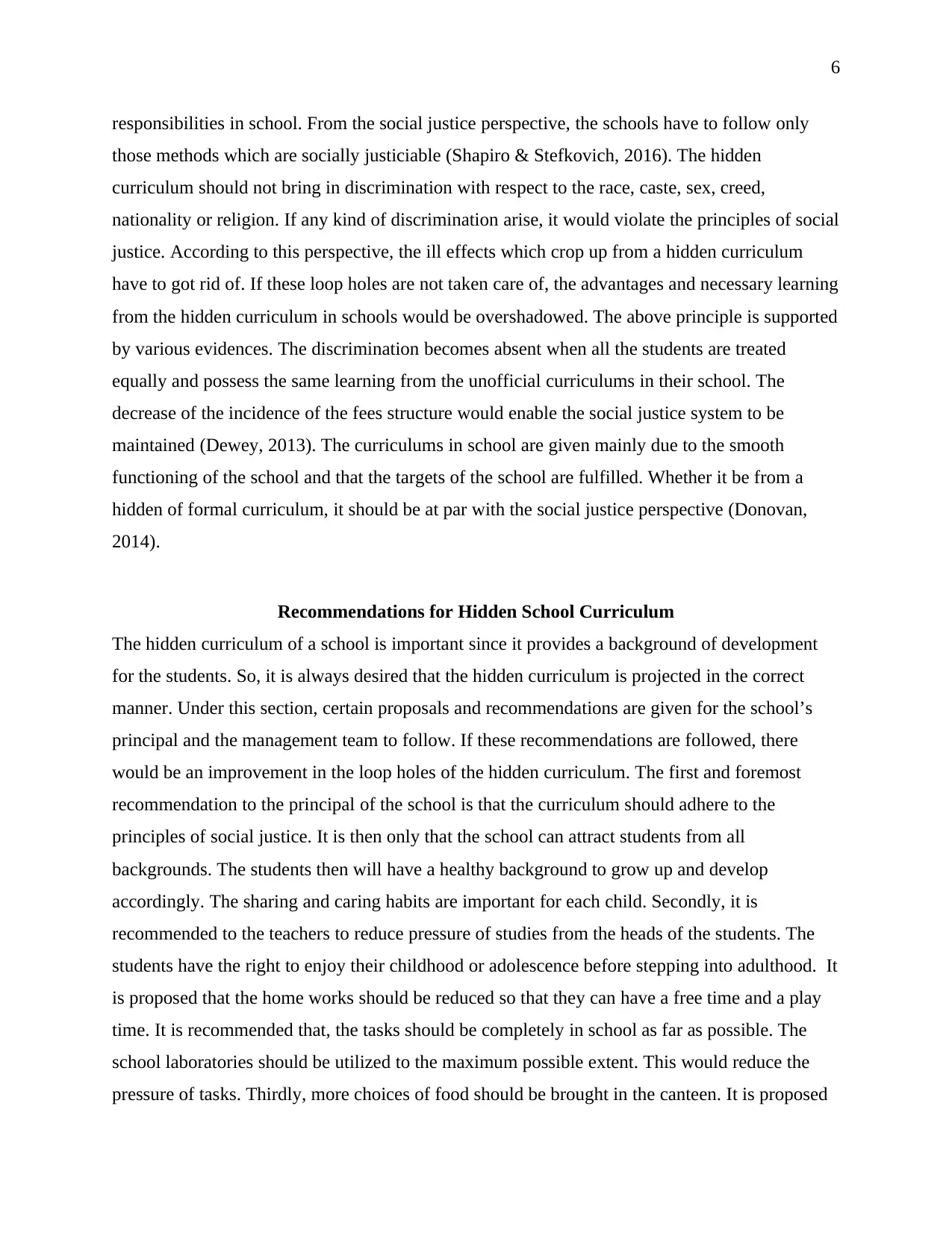
6
responsibilities in school. From the social justice perspective, the schools have to follow only
those methods which are socially justiciable (Shapiro & Stefkovich, 2016). The hidden
curriculum should not bring in discrimination with respect to the race, caste, sex, creed,
nationality or religion. If any kind of discrimination arise, it would violate the principles of social
justice. According to this perspective, the ill effects which crop up from a hidden curriculum
have to got rid of. If these loop holes are not taken care of, the advantages and necessary learning
from the hidden curriculum in schools would be overshadowed. The above principle is supported
by various evidences. The discrimination becomes absent when all the students are treated
equally and possess the same learning from the unofficial curriculums in their school. The
decrease of the incidence of the fees structure would enable the social justice system to be
maintained (Dewey, 2013). The curriculums in school are given mainly due to the smooth
functioning of the school and that the targets of the school are fulfilled. Whether it be from a
hidden of formal curriculum, it should be at par with the social justice perspective (Donovan,
2014).
Recommendations for Hidden School Curriculum
The hidden curriculum of a school is important since it provides a background of development
for the students. So, it is always desired that the hidden curriculum is projected in the correct
manner. Under this section, certain proposals and recommendations are given for the school’s
principal and the management team to follow. If these recommendations are followed, there
would be an improvement in the loop holes of the hidden curriculum. The first and foremost
recommendation to the principal of the school is that the curriculum should adhere to the
principles of social justice. It is then only that the school can attract students from all
backgrounds. The students then will have a healthy background to grow up and develop
accordingly. The sharing and caring habits are important for each child. Secondly, it is
recommended to the teachers to reduce pressure of studies from the heads of the students. The
students have the right to enjoy their childhood or adolescence before stepping into adulthood. It
is proposed that the home works should be reduced so that they can have a free time and a play
time. It is recommended that, the tasks should be completely in school as far as possible. The
school laboratories should be utilized to the maximum possible extent. This would reduce the
pressure of tasks. Thirdly, more choices of food should be brought in the canteen. It is proposed
responsibilities in school. From the social justice perspective, the schools have to follow only
those methods which are socially justiciable (Shapiro & Stefkovich, 2016). The hidden
curriculum should not bring in discrimination with respect to the race, caste, sex, creed,
nationality or religion. If any kind of discrimination arise, it would violate the principles of social
justice. According to this perspective, the ill effects which crop up from a hidden curriculum
have to got rid of. If these loop holes are not taken care of, the advantages and necessary learning
from the hidden curriculum in schools would be overshadowed. The above principle is supported
by various evidences. The discrimination becomes absent when all the students are treated
equally and possess the same learning from the unofficial curriculums in their school. The
decrease of the incidence of the fees structure would enable the social justice system to be
maintained (Dewey, 2013). The curriculums in school are given mainly due to the smooth
functioning of the school and that the targets of the school are fulfilled. Whether it be from a
hidden of formal curriculum, it should be at par with the social justice perspective (Donovan,
2014).
Recommendations for Hidden School Curriculum
The hidden curriculum of a school is important since it provides a background of development
for the students. So, it is always desired that the hidden curriculum is projected in the correct
manner. Under this section, certain proposals and recommendations are given for the school’s
principal and the management team to follow. If these recommendations are followed, there
would be an improvement in the loop holes of the hidden curriculum. The first and foremost
recommendation to the principal of the school is that the curriculum should adhere to the
principles of social justice. It is then only that the school can attract students from all
backgrounds. The students then will have a healthy background to grow up and develop
accordingly. The sharing and caring habits are important for each child. Secondly, it is
recommended to the teachers to reduce pressure of studies from the heads of the students. The
students have the right to enjoy their childhood or adolescence before stepping into adulthood. It
is proposed that the home works should be reduced so that they can have a free time and a play
time. It is recommended that, the tasks should be completely in school as far as possible. The
school laboratories should be utilized to the maximum possible extent. This would reduce the
pressure of tasks. Thirdly, more choices of food should be brought in the canteen. It is proposed
⊘ This is a preview!⊘
Do you want full access?
Subscribe today to unlock all pages.

Trusted by 1+ million students worldwide
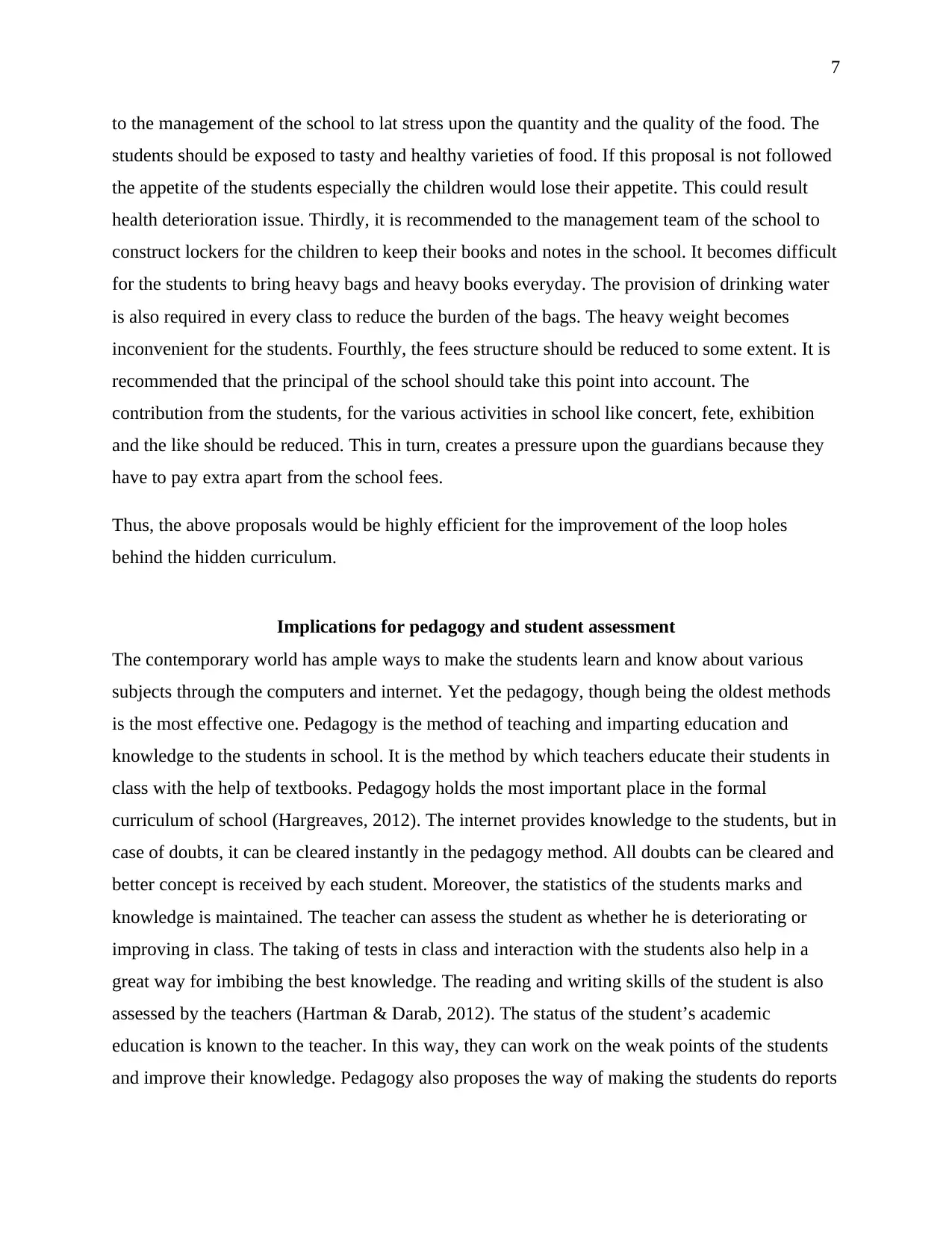
7
to the management of the school to lat stress upon the quantity and the quality of the food. The
students should be exposed to tasty and healthy varieties of food. If this proposal is not followed
the appetite of the students especially the children would lose their appetite. This could result
health deterioration issue. Thirdly, it is recommended to the management team of the school to
construct lockers for the children to keep their books and notes in the school. It becomes difficult
for the students to bring heavy bags and heavy books everyday. The provision of drinking water
is also required in every class to reduce the burden of the bags. The heavy weight becomes
inconvenient for the students. Fourthly, the fees structure should be reduced to some extent. It is
recommended that the principal of the school should take this point into account. The
contribution from the students, for the various activities in school like concert, fete, exhibition
and the like should be reduced. This in turn, creates a pressure upon the guardians because they
have to pay extra apart from the school fees.
Thus, the above proposals would be highly efficient for the improvement of the loop holes
behind the hidden curriculum.
Implications for pedagogy and student assessment
The contemporary world has ample ways to make the students learn and know about various
subjects through the computers and internet. Yet the pedagogy, though being the oldest methods
is the most effective one. Pedagogy is the method of teaching and imparting education and
knowledge to the students in school. It is the method by which teachers educate their students in
class with the help of textbooks. Pedagogy holds the most important place in the formal
curriculum of school (Hargreaves, 2012). The internet provides knowledge to the students, but in
case of doubts, it can be cleared instantly in the pedagogy method. All doubts can be cleared and
better concept is received by each student. Moreover, the statistics of the students marks and
knowledge is maintained. The teacher can assess the student as whether he is deteriorating or
improving in class. The taking of tests in class and interaction with the students also help in a
great way for imbibing the best knowledge. The reading and writing skills of the student is also
assessed by the teachers (Hartman & Darab, 2012). The status of the student’s academic
education is known to the teacher. In this way, they can work on the weak points of the students
and improve their knowledge. Pedagogy also proposes the way of making the students do reports
to the management of the school to lat stress upon the quantity and the quality of the food. The
students should be exposed to tasty and healthy varieties of food. If this proposal is not followed
the appetite of the students especially the children would lose their appetite. This could result
health deterioration issue. Thirdly, it is recommended to the management team of the school to
construct lockers for the children to keep their books and notes in the school. It becomes difficult
for the students to bring heavy bags and heavy books everyday. The provision of drinking water
is also required in every class to reduce the burden of the bags. The heavy weight becomes
inconvenient for the students. Fourthly, the fees structure should be reduced to some extent. It is
recommended that the principal of the school should take this point into account. The
contribution from the students, for the various activities in school like concert, fete, exhibition
and the like should be reduced. This in turn, creates a pressure upon the guardians because they
have to pay extra apart from the school fees.
Thus, the above proposals would be highly efficient for the improvement of the loop holes
behind the hidden curriculum.
Implications for pedagogy and student assessment
The contemporary world has ample ways to make the students learn and know about various
subjects through the computers and internet. Yet the pedagogy, though being the oldest methods
is the most effective one. Pedagogy is the method of teaching and imparting education and
knowledge to the students in school. It is the method by which teachers educate their students in
class with the help of textbooks. Pedagogy holds the most important place in the formal
curriculum of school (Hargreaves, 2012). The internet provides knowledge to the students, but in
case of doubts, it can be cleared instantly in the pedagogy method. All doubts can be cleared and
better concept is received by each student. Moreover, the statistics of the students marks and
knowledge is maintained. The teacher can assess the student as whether he is deteriorating or
improving in class. The taking of tests in class and interaction with the students also help in a
great way for imbibing the best knowledge. The reading and writing skills of the student is also
assessed by the teachers (Hartman & Darab, 2012). The status of the student’s academic
education is known to the teacher. In this way, they can work on the weak points of the students
and improve their knowledge. Pedagogy also proposes the way of making the students do reports
Paraphrase This Document
Need a fresh take? Get an instant paraphrase of this document with our AI Paraphraser
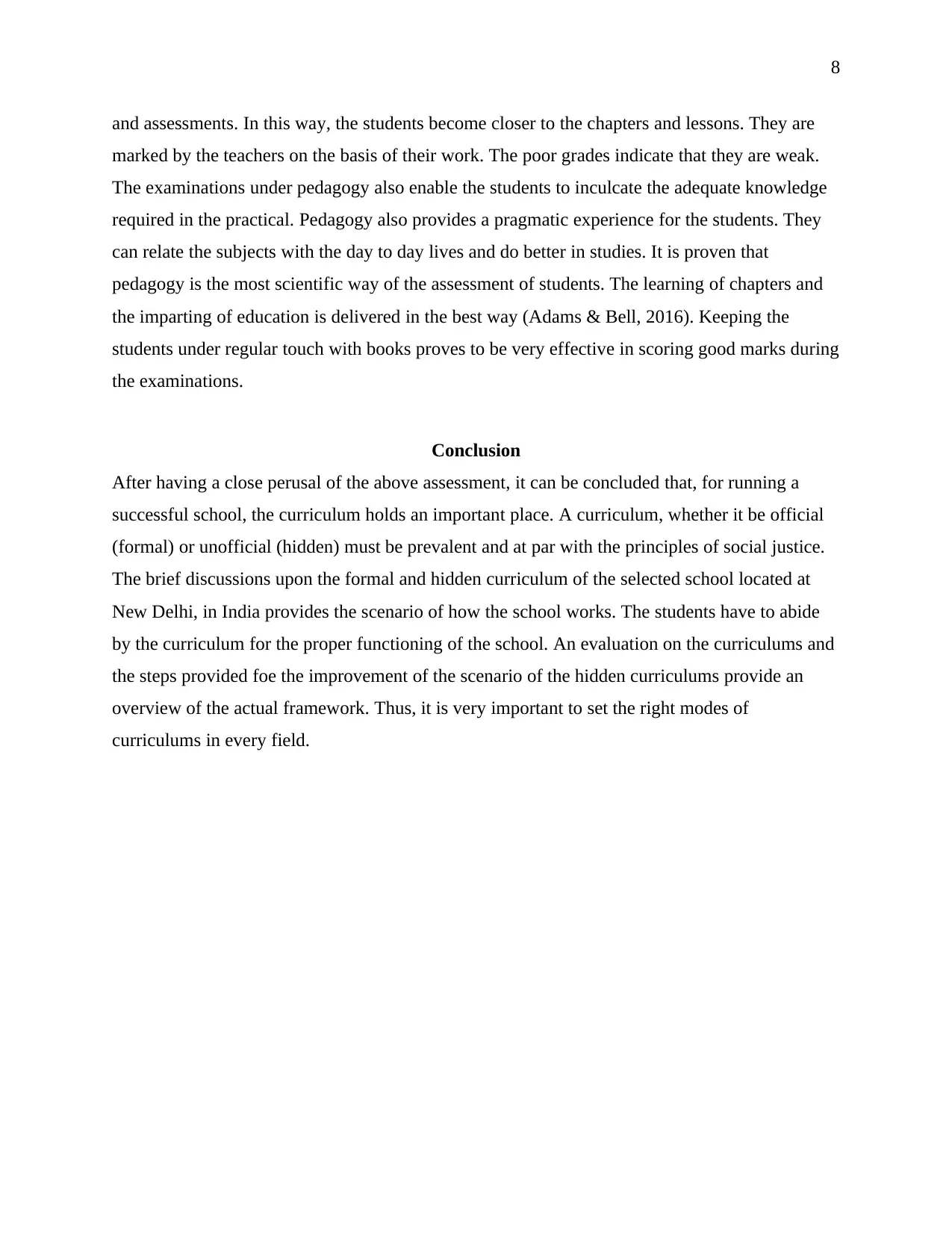
8
and assessments. In this way, the students become closer to the chapters and lessons. They are
marked by the teachers on the basis of their work. The poor grades indicate that they are weak.
The examinations under pedagogy also enable the students to inculcate the adequate knowledge
required in the practical. Pedagogy also provides a pragmatic experience for the students. They
can relate the subjects with the day to day lives and do better in studies. It is proven that
pedagogy is the most scientific way of the assessment of students. The learning of chapters and
the imparting of education is delivered in the best way (Adams & Bell, 2016). Keeping the
students under regular touch with books proves to be very effective in scoring good marks during
the examinations.
Conclusion
After having a close perusal of the above assessment, it can be concluded that, for running a
successful school, the curriculum holds an important place. A curriculum, whether it be official
(formal) or unofficial (hidden) must be prevalent and at par with the principles of social justice.
The brief discussions upon the formal and hidden curriculum of the selected school located at
New Delhi, in India provides the scenario of how the school works. The students have to abide
by the curriculum for the proper functioning of the school. An evaluation on the curriculums and
the steps provided foe the improvement of the scenario of the hidden curriculums provide an
overview of the actual framework. Thus, it is very important to set the right modes of
curriculums in every field.
and assessments. In this way, the students become closer to the chapters and lessons. They are
marked by the teachers on the basis of their work. The poor grades indicate that they are weak.
The examinations under pedagogy also enable the students to inculcate the adequate knowledge
required in the practical. Pedagogy also provides a pragmatic experience for the students. They
can relate the subjects with the day to day lives and do better in studies. It is proven that
pedagogy is the most scientific way of the assessment of students. The learning of chapters and
the imparting of education is delivered in the best way (Adams & Bell, 2016). Keeping the
students under regular touch with books proves to be very effective in scoring good marks during
the examinations.
Conclusion
After having a close perusal of the above assessment, it can be concluded that, for running a
successful school, the curriculum holds an important place. A curriculum, whether it be official
(formal) or unofficial (hidden) must be prevalent and at par with the principles of social justice.
The brief discussions upon the formal and hidden curriculum of the selected school located at
New Delhi, in India provides the scenario of how the school works. The students have to abide
by the curriculum for the proper functioning of the school. An evaluation on the curriculums and
the steps provided foe the improvement of the scenario of the hidden curriculums provide an
overview of the actual framework. Thus, it is very important to set the right modes of
curriculums in every field.
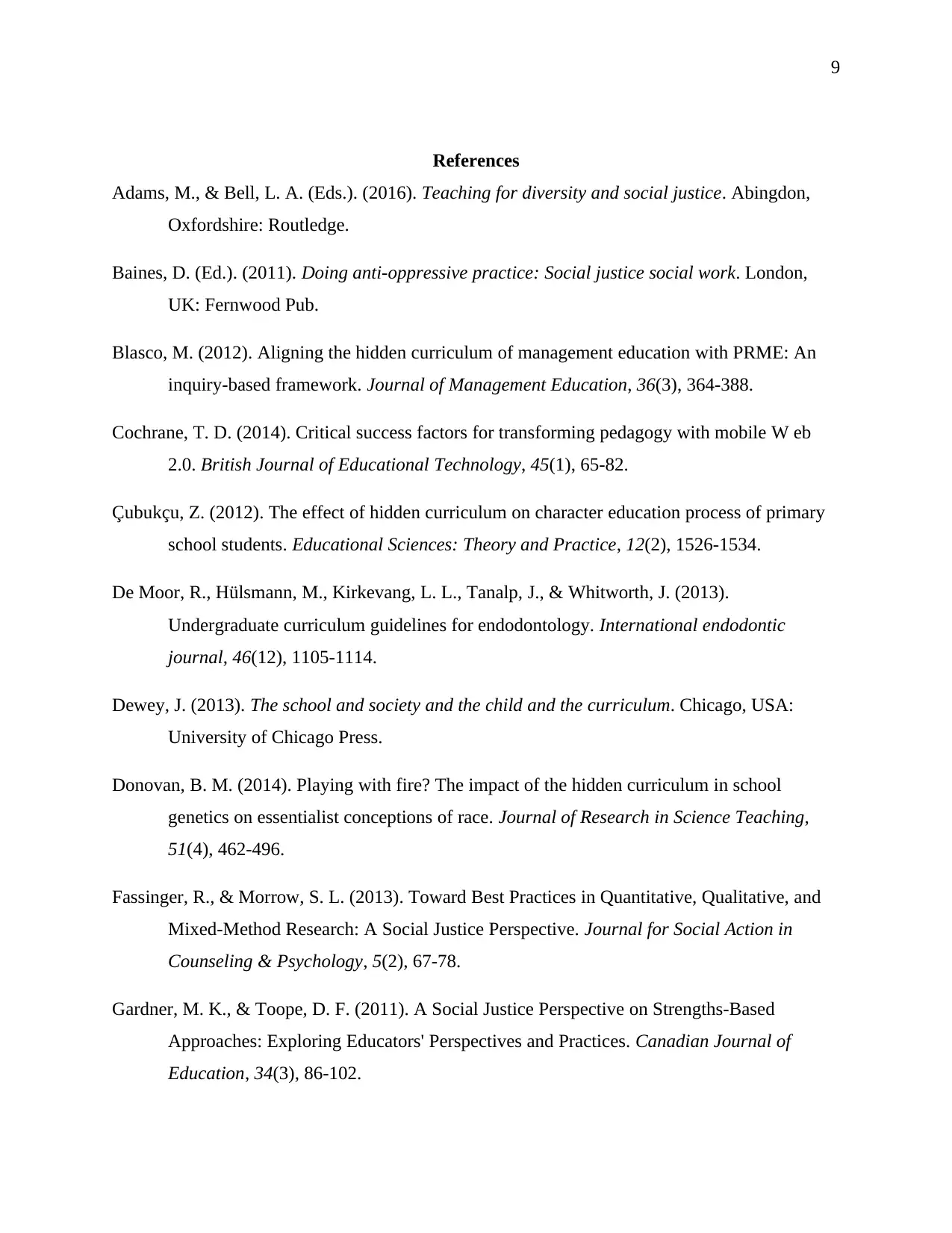
9
References
Adams, M., & Bell, L. A. (Eds.). (2016). Teaching for diversity and social justice. Abingdon,
Oxfordshire: Routledge.
Baines, D. (Ed.). (2011). Doing anti-oppressive practice: Social justice social work. London,
UK: Fernwood Pub.
Blasco, M. (2012). Aligning the hidden curriculum of management education with PRME: An
inquiry-based framework. Journal of Management Education, 36(3), 364-388.
Cochrane, T. D. (2014). Critical success factors for transforming pedagogy with mobile W eb
2.0. British Journal of Educational Technology, 45(1), 65-82.
Çubukçu, Z. (2012). The effect of hidden curriculum on character education process of primary
school students. Educational Sciences: Theory and Practice, 12(2), 1526-1534.
De Moor, R., Hülsmann, M., Kirkevang, L. L., Tanalp, J., & Whitworth, J. (2013).
Undergraduate curriculum guidelines for endodontology. International endodontic
journal, 46(12), 1105-1114.
Dewey, J. (2013). The school and society and the child and the curriculum. Chicago, USA:
University of Chicago Press.
Donovan, B. M. (2014). Playing with fire? The impact of the hidden curriculum in school
genetics on essentialist conceptions of race. Journal of Research in Science Teaching,
51(4), 462-496.
Fassinger, R., & Morrow, S. L. (2013). Toward Best Practices in Quantitative, Qualitative, and
Mixed-Method Research: A Social Justice Perspective. Journal for Social Action in
Counseling & Psychology, 5(2), 67-78.
Gardner, M. K., & Toope, D. F. (2011). A Social Justice Perspective on Strengths-Based
Approaches: Exploring Educators' Perspectives and Practices. Canadian Journal of
Education, 34(3), 86-102.
References
Adams, M., & Bell, L. A. (Eds.). (2016). Teaching for diversity and social justice. Abingdon,
Oxfordshire: Routledge.
Baines, D. (Ed.). (2011). Doing anti-oppressive practice: Social justice social work. London,
UK: Fernwood Pub.
Blasco, M. (2012). Aligning the hidden curriculum of management education with PRME: An
inquiry-based framework. Journal of Management Education, 36(3), 364-388.
Cochrane, T. D. (2014). Critical success factors for transforming pedagogy with mobile W eb
2.0. British Journal of Educational Technology, 45(1), 65-82.
Çubukçu, Z. (2012). The effect of hidden curriculum on character education process of primary
school students. Educational Sciences: Theory and Practice, 12(2), 1526-1534.
De Moor, R., Hülsmann, M., Kirkevang, L. L., Tanalp, J., & Whitworth, J. (2013).
Undergraduate curriculum guidelines for endodontology. International endodontic
journal, 46(12), 1105-1114.
Dewey, J. (2013). The school and society and the child and the curriculum. Chicago, USA:
University of Chicago Press.
Donovan, B. M. (2014). Playing with fire? The impact of the hidden curriculum in school
genetics on essentialist conceptions of race. Journal of Research in Science Teaching,
51(4), 462-496.
Fassinger, R., & Morrow, S. L. (2013). Toward Best Practices in Quantitative, Qualitative, and
Mixed-Method Research: A Social Justice Perspective. Journal for Social Action in
Counseling & Psychology, 5(2), 67-78.
Gardner, M. K., & Toope, D. F. (2011). A Social Justice Perspective on Strengths-Based
Approaches: Exploring Educators' Perspectives and Practices. Canadian Journal of
Education, 34(3), 86-102.
⊘ This is a preview!⊘
Do you want full access?
Subscribe today to unlock all pages.

Trusted by 1+ million students worldwide
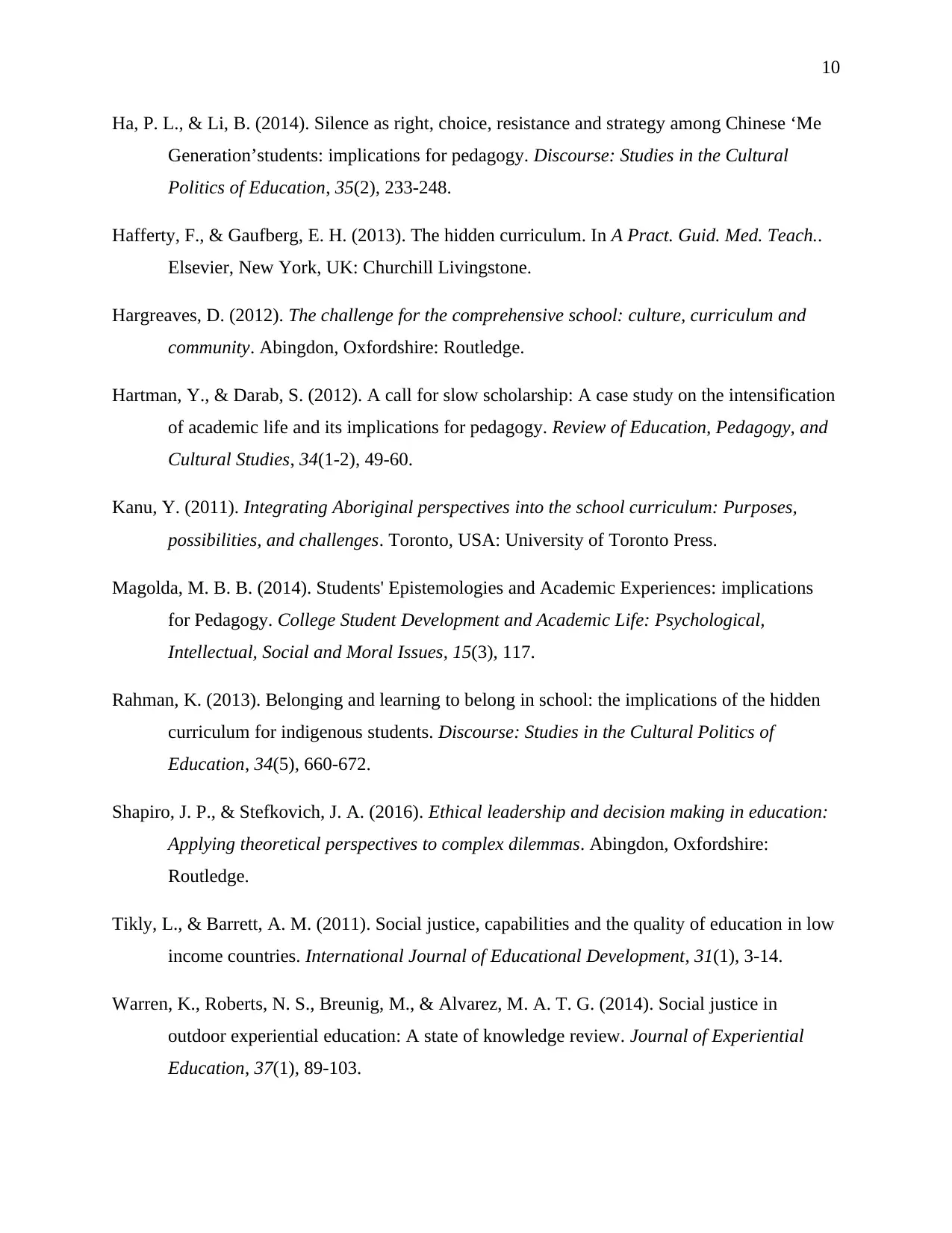
10
Ha, P. L., & Li, B. (2014). Silence as right, choice, resistance and strategy among Chinese ‘Me
Generation’students: implications for pedagogy. Discourse: Studies in the Cultural
Politics of Education, 35(2), 233-248.
Hafferty, F., & Gaufberg, E. H. (2013). The hidden curriculum. In A Pract. Guid. Med. Teach..
Elsevier, New York, UK: Churchill Livingstone.
Hargreaves, D. (2012). The challenge for the comprehensive school: culture, curriculum and
community. Abingdon, Oxfordshire: Routledge.
Hartman, Y., & Darab, S. (2012). A call for slow scholarship: A case study on the intensification
of academic life and its implications for pedagogy. Review of Education, Pedagogy, and
Cultural Studies, 34(1-2), 49-60.
Kanu, Y. (2011). Integrating Aboriginal perspectives into the school curriculum: Purposes,
possibilities, and challenges. Toronto, USA: University of Toronto Press.
Magolda, M. B. B. (2014). Students' Epistemologies and Academic Experiences: implications
for Pedagogy. College Student Development and Academic Life: Psychological,
Intellectual, Social and Moral Issues, 15(3), 117.
Rahman, K. (2013). Belonging and learning to belong in school: the implications of the hidden
curriculum for indigenous students. Discourse: Studies in the Cultural Politics of
Education, 34(5), 660-672.
Shapiro, J. P., & Stefkovich, J. A. (2016). Ethical leadership and decision making in education:
Applying theoretical perspectives to complex dilemmas. Abingdon, Oxfordshire:
Routledge.
Tikly, L., & Barrett, A. M. (2011). Social justice, capabilities and the quality of education in low
income countries. International Journal of Educational Development, 31(1), 3-14.
Warren, K., Roberts, N. S., Breunig, M., & Alvarez, M. A. T. G. (2014). Social justice in
outdoor experiential education: A state of knowledge review. Journal of Experiential
Education, 37(1), 89-103.
Ha, P. L., & Li, B. (2014). Silence as right, choice, resistance and strategy among Chinese ‘Me
Generation’students: implications for pedagogy. Discourse: Studies in the Cultural
Politics of Education, 35(2), 233-248.
Hafferty, F., & Gaufberg, E. H. (2013). The hidden curriculum. In A Pract. Guid. Med. Teach..
Elsevier, New York, UK: Churchill Livingstone.
Hargreaves, D. (2012). The challenge for the comprehensive school: culture, curriculum and
community. Abingdon, Oxfordshire: Routledge.
Hartman, Y., & Darab, S. (2012). A call for slow scholarship: A case study on the intensification
of academic life and its implications for pedagogy. Review of Education, Pedagogy, and
Cultural Studies, 34(1-2), 49-60.
Kanu, Y. (2011). Integrating Aboriginal perspectives into the school curriculum: Purposes,
possibilities, and challenges. Toronto, USA: University of Toronto Press.
Magolda, M. B. B. (2014). Students' Epistemologies and Academic Experiences: implications
for Pedagogy. College Student Development and Academic Life: Psychological,
Intellectual, Social and Moral Issues, 15(3), 117.
Rahman, K. (2013). Belonging and learning to belong in school: the implications of the hidden
curriculum for indigenous students. Discourse: Studies in the Cultural Politics of
Education, 34(5), 660-672.
Shapiro, J. P., & Stefkovich, J. A. (2016). Ethical leadership and decision making in education:
Applying theoretical perspectives to complex dilemmas. Abingdon, Oxfordshire:
Routledge.
Tikly, L., & Barrett, A. M. (2011). Social justice, capabilities and the quality of education in low
income countries. International Journal of Educational Development, 31(1), 3-14.
Warren, K., Roberts, N. S., Breunig, M., & Alvarez, M. A. T. G. (2014). Social justice in
outdoor experiential education: A state of knowledge review. Journal of Experiential
Education, 37(1), 89-103.
Paraphrase This Document
Need a fresh take? Get an instant paraphrase of this document with our AI Paraphraser
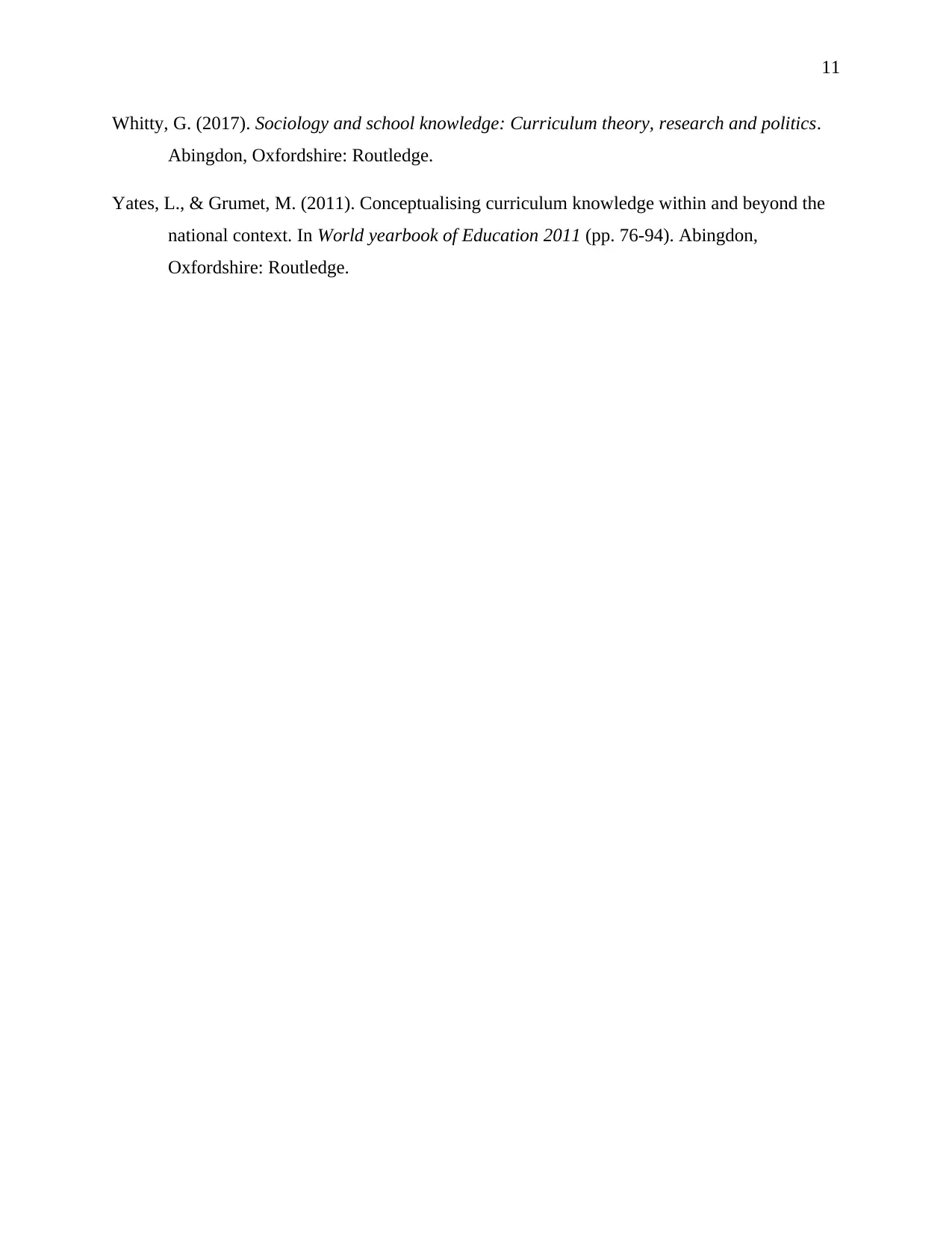
11
Whitty, G. (2017). Sociology and school knowledge: Curriculum theory, research and politics.
Abingdon, Oxfordshire: Routledge.
Yates, L., & Grumet, M. (2011). Conceptualising curriculum knowledge within and beyond the
national context. In World yearbook of Education 2011 (pp. 76-94). Abingdon,
Oxfordshire: Routledge.
Whitty, G. (2017). Sociology and school knowledge: Curriculum theory, research and politics.
Abingdon, Oxfordshire: Routledge.
Yates, L., & Grumet, M. (2011). Conceptualising curriculum knowledge within and beyond the
national context. In World yearbook of Education 2011 (pp. 76-94). Abingdon,
Oxfordshire: Routledge.
1 out of 11
Related Documents
Your All-in-One AI-Powered Toolkit for Academic Success.
+13062052269
info@desklib.com
Available 24*7 on WhatsApp / Email
![[object Object]](/_next/static/media/star-bottom.7253800d.svg)
Unlock your academic potential
Copyright © 2020–2025 A2Z Services. All Rights Reserved. Developed and managed by ZUCOL.





